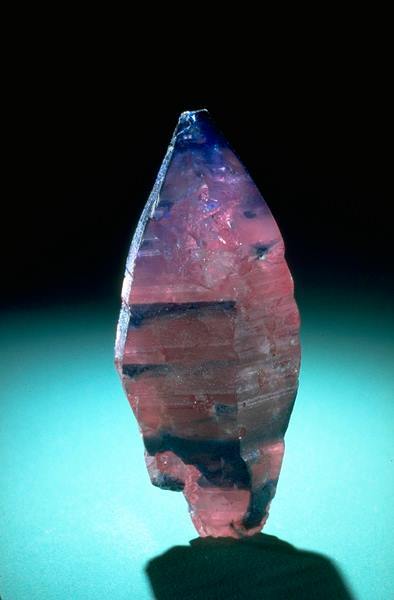Ruby and sapphire, intergrown…In a recent post we shared a corundum crystal from Nepal in whi
Ruby and sapphire, intergrown…In a recent post we shared a corundum crystal from Nepal in which a ruby crust had overgrown a blue sapphire core (please take a glance at this point athttp://tinyurl.com/p8zqzxb). The specimen in this photo is also a metamorphic gem, from the buried palaeo-river gravels of Sri Lanka/Ceylon, which record the erosion of no longer existing source rocks. Unlike theNepali stone featured in the last post, which is relatively young, Sri Lankan gems record a much older episode of mountain building, over half a billion years ago.As the landmasses that we now know as Antarctica, India, Australia, Africa and South America were grinding together to form Gondwana in what geologists affectionately term the Pan African event, the crust piled up as the Himalayas and Alps are today, and the intense heat and pressure below this thickened crust transformed transformed or melted the crust in mountain building events, distilling granites that spat out pegmatites as they cooled, focussing fluids filled with the rare elements necessary for gem formation through widespread fault systems.Africa was squeezed, heated and transformed from both sides, as they was impacted by continental collisions. Two ancient oceans closed, the western one bringing South America barging in, and the eastern carrying India, Antarctica, Sri Lanka and Madagascar behind it. Huge mountain belts thousands of miles long were pushed up as the Earth buckled and heated, while the lower crust melted and produced granites that spread around these newly minted gemlands in an orgy of transformation. Rare elements were concentrated from many different rock types as they partly melted, and were eventually incorporated into the last remnants of the granitic magmas known as pegmatites. These cooled slowly, allowing large gemmy crystals of many minerals to grow, such as from beryls, alexandrite and tourmaline. The chemistry of the original magmas decided each region’s bounty, and as always in the minerals game, some parts got better endowed than others. Other gems, including corundums (ruby and sapphire), tanzanite and many types of garnet formed through the direct metamorphism of rocks crushed under rising mountains or hot mineralised fluids given off by baked rocks precipitating crystals in veins.The Mozambique fold belt formed deep within one of the longest mountain chains as Archaean rocks were transformed, extending down the length of Africa from Arabia to Antarctica, and including all the gem producing areas listed above. Deformation from these events extended all the way to Western Australia, at the time way over on the other side of Antarctica. Composed of high grade gneisses (amphibolite to granulite facies), intruded by many kinds of granitoid rocks, they form the matrix of the region I call the gemlands. Pegmatite fields abound, as do placer deposits and strata bearing metamorphic gem crystals.These chunks of crust have since been spread around the globe by continental drift, after the rifting of Gondwana into its constituent parts during the Cretaceous. They were slowly uncovered by aeons of further uplift and erosion cycles. Different levels of the crust are exposed in the various countries, due to uneven erosion, in turn related to variations in climate as they drifted around the globe (or in Africa’s case, maybe traumatised by the collision remaining mostly still while the rest moved away). As a result, in Kenya and Tanzania, gems are found in rivers and mined directly from the rock. In Sri Lanka, the original source rocks were eroded away, and the gems are found in old river gravels many metres below ground.Unlike the crystal in the last post, which showed a clean overgrowth or ruby over a blue sapphire core, this one is more mixed, testifying to a more complex growth history. The horizontal lines across the crystal, some of them blue, reflect a phenomenon known as lamellar twinning, where new layers of crystal have grown in different directions, some with different impurities. The colouring elements, chromium for ruby, iron and titanium for sapphire were more mixed during this crystal’s growth, which was chemically mopre chaotic than the last one.LozImage credit: Chip ClarkeOur past posts on twinned crystals:http://tinyurl.com/mnn7twa, http://tinyurl.com/me9rpxh, http://tinyurl.com/mvbojuj,http://tinyurl.com/l8yba54, http://tinyurl.com/ntdtdb6,http://tinyurl.com/nr7cq6n, http://tinyurl.com/kp6nluf,http://tinyurl.com/nr7cq6n, http://tinyurl.com/o4dpbuvhttp://www.utdallas.edu/~rjstern/pdfs/PanAfricanOrogeny.pdfA map of the Pan African fold belts, http://web.earthsci.unimelb.edu.au/antarctica/images/pan-african.gifFirewall access: http://www.sciencedirect.com/science/article/pii/030192689090071W -- source link
#sapphire#corundum#mineral#minerals#gemstone#mineralogy#gemology#science#nature#crystal#crystals#twinning#twinned#metamorphic#sri lanka#gondwana#plate tectonics#himalayas#geology
